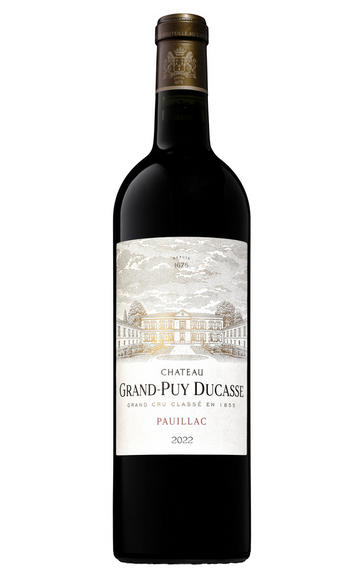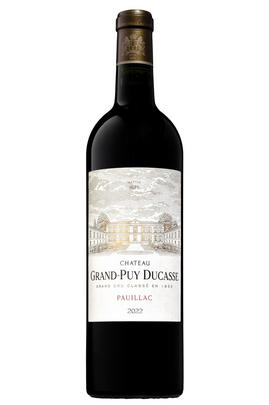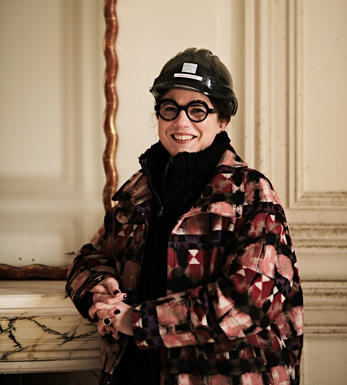
2022 Château Grand-Puy Ducasse, Pauillac, Bordeaux

Critics reviews
Inky colour, this is impressively structured right from the start, has a ton of dark chocolate, cassis, mint leaf, slate, has structure and character with a fresh cushion of acidity under the fruit. One of the more impressive vintages of this wine, worth looking out for, and should be good value.
Jane Anson, JaneAnson.com (May 2023)
58% Cabernet Sauvignon, 40% Merlot, 2% Petit Verdot. Cask sample.
Firm, steely, but poised. Dark fruit with a graphite edge. Plentiful tannins. Big structure. Potential for ageing.
Drink 2030 - 2045
James Lawther MW, JancisRobinson.com (May 2023)
The 2022 Grand-Puy-Ducasse exhibits notes of sweet plums and cherries mingled with liquorice and spices. Medium to full-bodied, taut and chalky, with a sweet, concentrated core of fruit and a penetrating finish, it's a youthfully structured effort that concludes with a somewhat drying finish.
William Kelley, Wine Advocate (April 2023)
Beautiful texture here. Tannins are dense and compact but finely polished and silky. Seamless and even with length and succulence. Medium- to full-bodied. Power with elegance. Endless for this.
Finally the best ever.
James Suckling, JamesSuckling.com (April 2023)
Ripe and filling, the blackcurrant and black cherry fruit are ripe and fleshy, with a pleasant chewy sensation on the palate as well as cool blue fruit and chalky, minty, liquorice-laced edges with fresh mint and crushed stones which give the minerality and the sense of gravel.
I like the powerful undertone here; this has structure, backbone, a real drive, and a sense of stateliness. Quiet, less overtly lively than some, more strict but also more serious in a good way. Tasted twice.
Drink 2027 - 2049
Georgina Hindle, Decanter.com (April 2023)
About this WINE

Château Grand-Puy Ducasse
Unusually, Château Grand-Puy Ducasse is located within the town of Pauillac; most other châteaux are situated within the vineyard areas surrounding it. The château is currently a construction site, part of an ambitious project known as “Renaissance”. Construction has faced considerable starts and stops – not least because of a family of house martins that forced workers to down tools for six months. Winemaker and director Anne Le Naour (pictured) hopes to be finished in time for the 2023 vintage.
The vineyard is broken up into different plots scattered throughout the appellation, making the estate “the most representative of the diversity of Pauillac’s soils”, Anne believes. There is a new label here since the 2020 vintage, part of a concerted effort to signify a new era, and perhaps to shake off old associations. Much of the production was once sold to French supermarkets. “The focus was on quantity, not quality,” Anne says.
To turn things around, she focused first on restoring and improving the vineyard. It took her almost a decade to convince the shareholders to make the necessary investment in the winery, but the work is now well underway. This is something of an untouched Pauillac property, still flying under the radar – for now.

Pauillac
Pauillac is the aristocrat of the Médoc boasting boasting 75 percent of the region’s First Growths and with Grand Cru Classés representing 84 percent of Pauillac's production.
For a small town, surrounded by so many familiar and regal names, Pauillac imparts a slightly seedy impression. There are no grand hotels or restaurants – with the honourable exception of the establishments owned by Jean-Michel Cazes – rather a small port and yacht harbour, and a dominant petrochemical plant.
Yet outside the town, , there is arguably the greatest concentration of fabulous vineyards throughout all Bordeaux, including three of the five First Growths. Bordering St Estèphe to the north and St Julien to the south, Pauillac has fine, deep gravel soils with important iron and marl deposits, and a subtle, softly-rolling landscape, cut by a series of small streams running into the Gironde. The vineyards are located on two gravel-rich plateaux, one to the northwest of the town of Pauillac and the other to the south, with the vines reaching a greater depth than anywhere else in the Médoc.
Pauillac's first growths each have their own unique characteristics; Lafite Rothschild, tucked in the northern part of Pauillac on the St Estèphe border, produces Pauillac's most aromatically complex and subtly-flavoured wine. Mouton Rothschild's vineyards lie on a well-drained gravel ridge and - with its high percentage of Cabernet Sauvignon - can produce (in its best years) Pauillac's most decadently rich, fleshy and exotic wine.
Latour, arguably Bordeaux's most consistent First Growth, is located in southern Pauillac next to St Julien. Its soil is gravel-rich with superb drainage, and Latour's vines penetrate as far as five metres into the soil. It produces perhaps the most long-lived wines of the Médoc.
Recommended Châteaux
Ch. Lafite-Rothschild, Ch. Latour, Ch. Mouton-Rothschild, Ch. Pichon-Longueville Baron, Ch. Pichon Longueville Comtesse de Lalande, Ch. Lynch-Bages, Ch. Grand-Puy-Lacoste, Ch, Pontet-Canet, Les Forts de Latour, Ch. Haut-Batailley, Ch. Batailley, Ch. Haut-Bages Libéral.

Cabernet Sauvignon Blend
Cabernet Sauvignon lends itself particularly well in blends with Merlot. This is actually the archetypal Bordeaux blend, though in different proportions in the sub-regions and sometimes topped up with Cabernet Franc, Malbec, and Petit Verdot.
In the Médoc and Graves the percentage of Cabernet Sauvignon in the blend can range from 95% (Mouton-Rothschild) to as low as 40%. It is particularly suited to the dry, warm, free- draining, gravel-rich soils and is responsible for the redolent cassis characteristics as well as the depth of colour, tannic structure and pronounced acidity of Médoc wines. However 100% Cabernet Sauvignon wines can be slightly hollow-tasting in the middle palate and Merlot with its generous, fleshy fruit flavours acts as a perfect foil by filling in this cavity.
In St-Emilion and Pomerol, the blends are Merlot dominated as Cabernet Sauvignon can struggle to ripen there - when it is included, it adds structure and body to the wine. Sassicaia is the most famous Bordeaux blend in Italy and has spawned many imitations, whereby the blend is now firmly established in the New World and particularly in California and Australia.


Buying options
Add to wishlist
Description
Blend: 58% Cabernet Sauvignon; 40% Merlot; 2% Petit Verdot
Crédit Agricole bought this estate in 2005; considerable work was required and is now being rewarded. The 40-hectare vineyard is split over 63 plots; over half needed replanting. Ten further years of research established the potential of each plot; the tapestry can now be stitched together.
This is perhaps a work in progress, but new opportunities at this level in Pauillac don’t often come around. This has plenty of density; you can feel the potential of the raw material and its ability to express the character of Pauillac. The wine is currently more solid than expressive, but it is definitely one to watch.
Drink 2027 - 2042
Score: 16/20
Berry Bros. & Rudd (April 2023)
wine at a glance
Delivery and quality guarantee